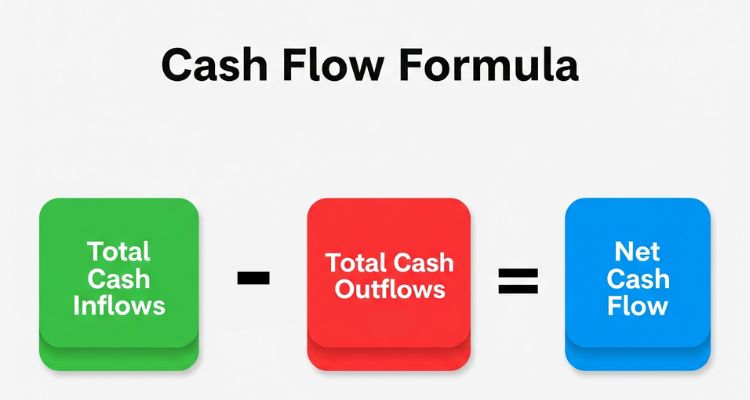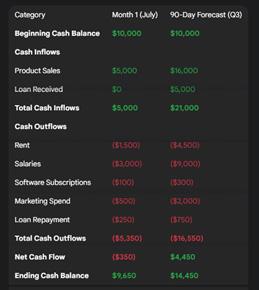Stop guessing and start forecasting. This guide employs a straightforward 7-step process to help you master your cash flow and transform your business from a chaotic startup into a stable company.
Introduction: The One Number That Matters Most
According to management theorist Henry Mintzberg, the reason is often structural. Startups begin with a “Simple Structure”, a flexible but chaotic stage where the founder makes every decision. While this allows for speed, it’s incredibly vulnerable to running out of cash.
The data is an alarm bell for every entrepreneur:
- A shocking 82% of small businesses fail due to poor cash flow management. (Source: Forbes)
- About 60% of small business owners feel that cash flow is a persistent challenge for their operations. (Source: Shishir Khadka)
- On average, small businesses only have enough cash in the bank to cover 27 days of expenses. (Source: JPMorgan Chase & Co.)
Profit is an opinion, but cash is a fact. Understanding your cash flow, the money moving in and out of your business, is the most critical skill for survival and growth. This guide will show you exactly how to do it in a few simple steps.
How to Create Your Cash Flow Overview: The 7 Steps
Step 1: Determine the Time You Will Analyze
First, decide on the time frame. For a new business, a monthly overview is essential for tight control. As you become more stable, you can expand to a quarterly (90-day) and annual forecast to get a bigger-picture perspective.
For more advanced, real-time tracking, many businesses use professional accounting software like QuickBooks or Xero to automate their cash flow forecasts.
Step 2: Gather All Financial Statements and Documents
Collect all the documents that show your income and expenses. This includes bank statements, invoices, receipts, and any loan documents. Having everything in one place makes the next steps much easier and more accurate.
Step 3: Create a List of All Income Sources (Cash Inflows)
This is all the money coming into your business during your chosen time. Be sure to list every source of cash.
Start with your Beginning Cash Balance: the total amount of cash you have in the bank at the start of the month.
Then, add all your projected cash inflows:
- Sales Revenue: All the money you receive from customers.
- Loan Payments: Any funds you receive from a loan.
- Investor Capital: Money from investors.
- Other Income: Things like asset sales or interest earned.

Step 4: Create a List of All Expenses (Cash Outflows)
This is all the money going out of your business during the same period. This is where many entrepreneurs make mistakes, so be ruthlessly detailed here.
Your cash outflows can be broken down into two main types:
- Fixed Costs: Expenses that stay the same every month, like rent, salaries, and insurance.
- Variable Costs: Expenses that change with your sales activity, like cost of goods sold (COGS), shipping fees, and marketing spend.
Don’t forget to include taxes, loan repayments, and any one-time purchases.
Step 5: Calculate Your Net Cash Flow and Ending Balance
Now it’s time for some simple math. The formula is:
Total Cash Inflows – Total Cash Outflows = Net Cash Flow
If your Net Cash Flow is positive, you brought in more money than you spent. If it’s negative, you spent more than you brought in, which is a critical warning sign.
Finally, calculate your Ending Cash Balance:
Beginning Cash Balance + Net Cash Flow = Ending Cash Balance
This final number is your starting point for the next month, creating a rolling forecast that keeps you in control.

Step 6: Sum Up Your “Runway”
For startups, this is a crucial survival metric. Your “runway” is the number of months your business can survive before it runs out of money, assuming your current income and expenses stay the same.
The formula is:
Total Cash in the Bank / Average Monthly Cash Burn (Negative Cash Flow) = Number of Months of Runway
Knowing you have “6 months of runway” gives you a clear deadline to either increase your sales or cut your costs before it’s too late.
Step 7: Repeat the Process Regularly
A cash flow overview is not a one-time document; it’s a living tool. By repeating this process every month, you learn the financial rhythm of your business, spot trends, and can make adjustments before problems become crises.
A Practical Example: Your First 90 Days of Cash Flow
To make this practical, here is a sample calculation for a fictional small business. This shows how to track your cash flow for one month and how to forecast it for a 90-day quarter.

Table:
| Cash Flow Overview | Month 1 (July) | 90-Day Forecast (Q3) |
| Beginning Cash Balance | $10,000 | $10,000 |
| Cash Inflows | ||
| Product Sales | $5,000 | $16,000 |
| Loan Received | $0 | $5,000 |
| Total Cash Inflows | $5,000 | $21,000 |
| Cash Outflows | ||
| Rent | ($1,500) | ($4,500) |
| Salaries | ($3,000) | ($9,000) |
| Software Subscriptions | ($100) | ($300) |
| Marketing Spend | ($500) | ($2,000) |
| Loan Repayment | ($250) | ($750) |
| Total Cash Outflows | ($5,350) | ($16,550) |
| Net Cash Flow (Inflows – Outflows) | ($350) | $4,450 |
| Ending Cash Balance | $9,650 | $14,450 |
This simple overview immediately tells the founder that while they will have a small cash burn in July, their business is projected to be strongly cash-flow positive over the next quarter, giving them the confidence to invest in growth.
Final Thoughts
Creating a cash flow overview can feel intimidating at first, but it is the most empowering financial exercise an entrepreneur can do. It transforms your relationship with your finances from one of fear and uncertainty to one of control and confidence.
This isn’t just a document for your bank or investors; it’s a living roadmap for your business. By tracking your cash flow, you gain the foresight to navigate challenges, the discipline to spend wisely, and the freedom to invest in growth.
Ready to take control of your finances? Download our Business & Financial Plan Bundle or go for our Financial Template here.
“Never take your eyes off the cash flow because it’s the lifeblood of business.” – Richard Branson
Invest the time to master this skill, and you will give your business the best possible chance to succeed.
Frequently Asked Questions (FAQs)
- What’s the difference between cash flow and profit?
Profit is the money that’s left over after you’ve paid all your expenses on paper. Cash flow is the actual money moving in and out of your bank account. A business can be profitable on paper but still fail because it runs out of cash to pay its bills. - How often should I update my cash flow statement?
When you’re starting, you should review and update your cash flow statement at least once a month. This will help you get a feel for the financial rhythm of your business and spot potential problems early. - What’s the most common cash flow mistake?
The most common mistake is being too optimistic about future sales while underestimating expenses. Always base your forecasts on realistic data, not just best-case scenarios.
References
- Mintzberg’s management roles. (n.d.). ACCA Global. https://www.accaglobal.com/pk/en/student/exam-support-resources/fundamentals-exams-study-resources/f1/technical-articles/mintzberg-theory.html
- Decoding Small Business Failures: Top Four Contributing Factors. (2024). Forbes. https://www.forbes.com/councils/forbestechcouncil/2024/02/27/decoding-small-business-failures-top-four-contributing-factors/
- Small Business Cash Flow Statistics. (2024). Shishir Khadka. https://shishirkhadka.com/cash-flow/statistics/
- Cash is King: Flows, Balances, and Buffer Days. (2016). JPMorgan Chase & Co. Institute. https://www.jpmorganchase.com/institute/research/small-business/report-cash-flows-balances-and-buffer-days

